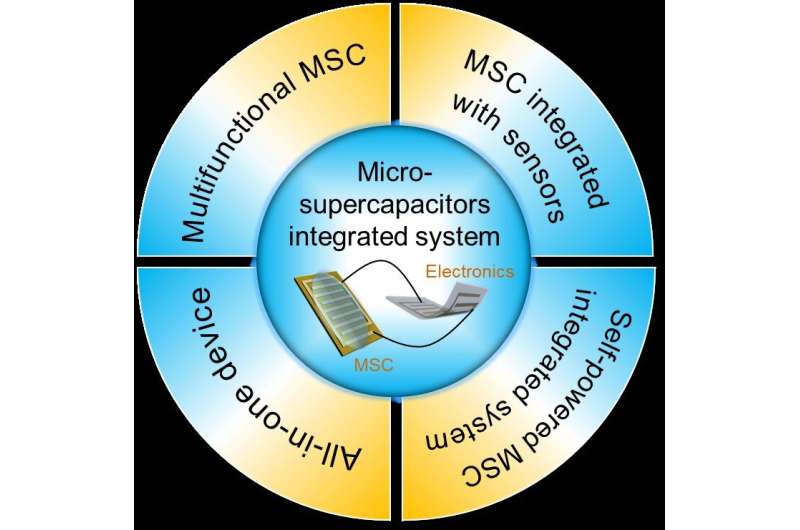More integrations and applications need to be involved with micro-supercapacitors

The development of wearable and portable electronics promotes the miniaturization of energy storage devices. Micro-supercapacitors (MSC) featuring fast charging and discharging rates, long cycle life, and high-power density stand out from miniaturized energy storage devices, particularly for their small size and adjustable structure, which are easily processed to integrate with other on-chip electronics. In their review of micro-supercapacitors, scientists from the Beijing Institute of Technology systematically analyzed the MSC integration with other electronics from the perspective of structures and functions. They published their work on Aug. 3rd in Energy Material Advances.
“The MSCs usually present planar structures, and the two electrodes are separated in plane without additional separator. The narrow electrode gap of MSC allows rapid transportation of electrolyte ions between the electrodes. Due to the short diffusion distance, charges are easy to be accumulated and released during charging and discharging procedure, enabling an ultrahigh power density of MSC for electrical appliances,” said corresponding author Liangti Qu, professor at Tsinghua University. “The ultrahigh power density of MSC promotes a large driving force for electrical appliances, thus the MSC shows a great potential in micro wearable electronics.”
Qu explained the advantages of the planar feature of MSC, especially for its small area, usually within a centimeters to micrometers footprint, which can be assembled in some portable electronic devices, such as integrated circuits on chips, micro robots and position indicators.
“The integration of MSCs and other electronics gradually become critical development directions of MSCs, and constitute an important part of future integrated circuits,” Qu said. “The integrated application of MSCs mainly involves the connections and matching degree between each electrical component, and the fitness of the materials and structures of the device. These discussions of the device have never been mentioned before.”
Focusing on the applications of multi-functional MSCs and MSC integrated circuits, Qu and his team introduced some special properties of multi-functional MSCs in the review. Additionally, from the perspective of integration, as the energy storage units, MSCs combining with energy-consuming devices (such as sensors) or energy-supplying devices are systematically discussed. To acquire a robust and compact structure, designing MSCs and various electronics into an all-in-one structure by using compatible materials is also listed. Finally, challenges and potential development of MSCs integrated systems are put forward.
“We surmised the research goal of MSC integrated systems in the review. The development of integrated MSC devices from simple, crude connection with metal wires to combination of all components into one shared substrate, and then to an organic unity in all-in-one structure makes the integrated MSCs device become more compact and robust,” Qu said.
“The integrating level of self-powered integrated devices composed of MSCs and energy generators is still far from satisfactory. Loose and rude connectivity between the power generating equipment and MSCs easily causes energy consumption, leading to low charging efficiency and insufficient charging voltage of MSCs,” Qu said.
“Although the development of structure and integration of MSCs system have solved this problem to a certain extent, few compatible and multifunctional materials can be chosen. Besides, the integrated device structure design is also difficult to meet most practical applications. To address these issues, the multifunctional compatible materials and the structural design of integrated devices between MSCs and other electronic components should be developed in future MSC integrated devices.”
Chang Gao et al, Recent Development of Integrated Systems of Microsupercapacitors, Energy Material Advances (2022). DOI: 10.34133/2022/9804891
Provided by
Beijing Institute of Technology Press Co., Ltd
Citation:
More integrations and applications need to be involved with micro-supercapacitors (2022, October 24)
retrieved 24 October 2022
from https://techxplore.com/news/2022-10-applications-involved-micro-supercapacitors.html
This document is subject to copyright. Apart from any fair dealing for the purpose of private study or research, no
part may be reproduced without the written permission. The content is provided for information purposes only.
For all the latest Technology News Click Here
For the latest news and updates, follow us on Google News.

